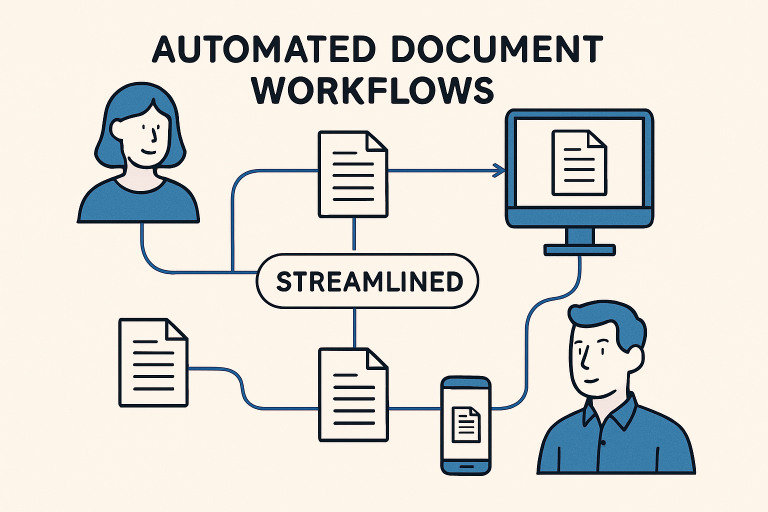Introduction
Organizations increasingly turn to modern solutions to manage their document processes in today’s competitive business world. Whether you’re a large or growing enterprise, streamlining document workflows can enhance productivity, reduce costs, and help maintain compliance. Leveraging advanced legal entity management software can significantly minimize errors and remove bottlenecks from your operations, all while enhancing collaboration across teams. These software solutions integrate automation, digitization, and compliance into a single streamlined process, ensuring that your compliance and documentation needs are always met efficiently.
Seamless document management is essential for improved business outcomes, better security, and aligned teamwork. Efficient workflows powered by modern legal entity management software free up valuable time for staff to focus on critical business goals instead of repetitive administrative tasks. This article will guide you through key strategies businesses should consider to optimize their document workflows in the digital era.
Utilizing Automation Tools
Automation plays a critical role in optimizing document management. Automating repetitive workflows—such as data entry, approval routing, and document storage—reduces the risk of errors and shortens processing times. Businesses using workflow automation software have reported up to a 16% reduction in task completion time, resulting in faster turnaround and improved operational efficiency.
According to Forbes, integrating automation capabilities is one of the easiest ways to enable staff to concentrate on high-value tasks, eliminate inefficiencies, and ensure a smooth flow of information throughout your organization.
Embracing Document Digitization
Transitioning to digital document management is no longer optional in today’s remote-centric work environments. Digitizing paperwork boosts accessibility, enhances collaboration, and facilitates compliance across distributed teams. Digital files are easier to share, version, and secure, reducing time spent searching for documents or worrying about lost information. Furthermore, digitization slashes printing, couriering, and physical storage costs.
A Forbes article highlights that organizations moving to digital document management see tangible productivity and cost savings boosts, making digitization a clear win for modern businesses.
Conducting Regular Workflow Analysis
Routine analysis of document workflows uncovers inefficiencies that slow down business processes. Companies can identify bottlenecks, redundancies, and outdated practices by visualizing and mapping each step. Leveraging workflow mapping tools or conducting periodic audits guarantees your document processes’ ongoing optimization and relevance. This proactive approach ensures every workflow adapts to new regulatory demands and evolving business goals, setting the foundation for scalable and reliable operations.
Enhancing Collaboration with Integrated Platforms
Integrated collaboration platforms centralize document access and streamline communication, making teamwork easier and more productive. With tools for real-time editing, version control, and secure sharing, these platforms eliminate confusion over document versions and ensure that stakeholders stay aligned. Implementing platforms like Microsoft Teams, Slack, or Google Workspace empowers teams to respond swiftly to business challenges, foster innovation, and achieve better project outcomes.

Implementing Robust Security Measures
Data protection is a top priority in managing sensitive documents. Key strategies include encrypting document transmissions, establishing granular access controls, and maintaining audit trails to monitor usage and prevent unauthorized access. Routine security audits and regulatory compliance checks are essential to shield your data from both internal risks and external threats. Following industry-recognized standards like SOC 2 and GDPR strengthens your security posture and builds trust among stakeholders and clients.
Investing in Employee Training Programs
Technology is only as good as the people using it. Regular employee training ensures that teams are familiar with new document management tools and best practices, keeping everyone up-to-date on compliance requirements and process changes. Well-trained employees are more adaptable, motivated, and effective at leveraging technology for better business outcomes, ultimately supporting your company’s continuous improvement efforts.
Monitoring Performance Metrics
Successful document management relies on analyzing performance data. Tracking key performance indicators (KPIs) such as document turnaround time, error frequency, and user satisfaction provides valuable insight into the effectiveness of your current workflows. Use this data to guide strategic adjustments, ensuring ongoing efficiency and user experience improvements. Regular performance monitoring keeps your workflows agile and responsive to changing business needs.
Fostering a Culture of Continuous Improvement
Building a culture that prioritizes ongoing optimization is crucial for long-term success in document management. Encourage employee feedback, stay informed about new trends, and proactively evaluate tools or methodologies that could benefit your operations. This forward-thinking mindset supports compliance and risk reduction and positions your organization to remain competitive and agile in any market environment.
Streamlining document workflows through automation, digitization, and continuous improvement creates a solid foundation for enhanced collaboration, security, and business growth. By adopting proven strategies and modern technology, businesses can confidently navigate the evolving digital landscape and set the standard for effective document management.